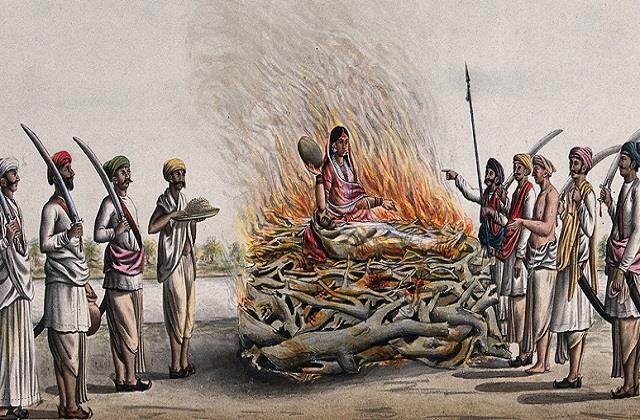Why Hindu women practiced Sati?


Originally a free act regarded as brave and heroic, the ancient Hindu tradition known as sati—wherein a widow would fling herself upon her husband’s pyre and burn to death—became a forced practise. Sati, despite being outlawed in India as of right now, has a sordid past.
What is Sati?
The term “Sati” originally referred to a woman who committed suicide after her spouse passed away. The phrase “She is pure or true” is the translation of the Sanskrit word “asti,” from which the word was derived.
The bride of Lord Shiva was known by the name Sati in Hindu culture. Shiva was never revered by her father, who frequently disliked him. She set herself ablaze in retaliation for her father’s animosity towards her husband. She prayed to be reborn as Shiva’s wife while she was burning. This did occur, and her subsequent rebirth was given the name Parvati. Using this story, people used to defend the practice, until Sati was caught when she burned herself.
Sati Pratha!
Sati pratha is a subject of much discussion. Ancient texts like the Valmiki Ramayana and the Vedas claim that the widow is frequently brought back to her home but do not mention sati. There are a few cases of women killing themselves in the later Mahabharata epic, although these are more often driven by severe sorrow or guilt, like in the case of Madri, who lamented the death of her spouse Pandu during intercourse. Like many other widows in Hastinapura, Kunti, Pandu’s other widow, led a comfortable life.
One may see that Buddha and Mahavira made no mention of this practice and that none of the ancient Buddhist or Jain scriptures reference it as more evidence that forced widow burning didn’t exist in ancient Hinduism. The question at hand is when it arrived and why. We must comprehend the areas where Sati is rife in order to get there.
The Rajput family in northwest India has a pervasive practice of Sati, although most other regions of India do not. For instance, there is no reference to Sati in any Tamil literature. Many well-known historical personalities, like Kannagi, were widows.
So what makes northwest India so unique? It is located close to where invasions enter the country. We saw the rise of Sati there. Some of the earliest instances of forced burning date back to the fall of the Gupta empire, which was under siege by invaders. At the time when they were written, the Puranas had mixed feelings toward Sati. While some praised the practice, others forbade it.
Yet, when the Muslims invaded Rajput territory in the 14th century, things truly went out of control. In order to avoid the consequences of invasions, such as mass rape and enslavement, Hindus committed mass suicides known as Jauhar. The most well-known example of this is Rani Padmini’s suicide during Alauddin Khilji’s invasion. This suicide was a significant trigger since it was widely lauded and exalted. Immediately, temples were built in honor of her sacrifice, and the suicide even had some positive connotations.
Upon her passing, Rani Padmini gained notoriety, and ever since, widows plunging into fire have become commonplace in that region. Women who objected were reprimanded or tossed into the flames.
The legend of Padmini and this horrific custom eventually reached other royal families, like the Marathas and Vijayanagara Nayaks.
Understanding the psychology of fear, namely the dread of conversions, is essential to understanding South Asia. Many of our politics and sins derive from the border region’s continued dread due to the tragic fate of Hindus in Pakistan. Some Hindus become paralyzed by fear and cease considering rational arguments. In Hinduism, this is regarded as the root of all evil. So, the objective is to encourage the community to overcome its fear and engage.
DISCLAIMER: The author is solely responsible for the views expressed in this article. The author carries the responsibility for citing and/or licensing of images utilized within the text.
